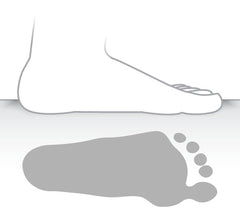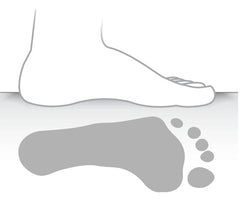Arch Height 101 - Do You Have High Arches, Flat Feet Or Something In Between?
|
Read time 7 min
|
Read time 7 min
Knowing your arch height helps you understand your body mechanics. Figuring out if you have sky high arches, the flattest of feet, or something in between, is the key to recognizing how your feet affect the rest of your body and the best way to take care of them.
Knowing your arch height can help you understand how your individual body mechanics work, why you might have foot pain, and which foot conditions you need to watch out for.
No matter your arch height, your feet require arch support. Even flat feet need support. And unless your shoes are custom, they don't have support built in. Adding insoles can with arch support that matches the contours of your feet will make the difference.
If it's your first time wearing insoles, or you're a walker, hiker or stand all day, we recommend adding Tread Labs Ramble Insoles to your shoes. If you have plantar fasciitis or other foot pain, are especially heavy on your feet, or overpronate severely, go for Pace Insoles. If you're a performance athlete or have especially flat feet, shop Dash Insoles.
Your arch height can impact your overall foot health, so figuring out if you have flat feet, medium or high arches is important. Luckily, there is an easy way to determine your arch height. It's called the “wet test.”
The "wet test" is as simple as stepping out of a shower or tub onto cardboard, concrete or heavy paper like a brown shopping bag. Once you have wet prints of both your feet, compare them to the chart below.
If you have flat feet, you'll need to take one extra step and compare your arch when it is weighted (as shown in your wet footprint) and unweighted (sitting down).
| What does your footprint look like? | Describe your arch | Your best insole arch height |
|---|---|---|
 |
My arch is flat when I sit or stand. | Low arch height insole |
 |
My arch is flat when I stand but appears when I sit |
Medium arch height insole |
 |
My arch is close to but does not touch the ground when I stand. | Medium arch height insole |
 |
My arch is high off the ground when I stand. | High arch height insole |
 |
No one has an arch higher than mine! | Extra high arch height insole |
Some people are born with high arches, some develop them as they age. If you're born with high arches, they probably run in your family. Developing high arches later in life is usually the result of external factors like an injury or weight gain, but it can also be a symptom of a neurological disorder so you'll want to see a medical professional about them.
People with high arches can often experience foot pain because of the extra stress high arches put on your metatarsal bones. The stress ends up shifting your weight to the ball of your foot. Other issues that come with having high arches include:
With high arches, underpronation (also called supination) is common. This can put too much pressure on the joints and muscles of the foot, ankle and leg causing issues like:
People with high arches need insoles that offer full support across the entire arch so as to eliminate excessive pressure on the ball and heel of the foot. The arch support of the insole should mimic the height of the arch of your foot and the insoles should be firm and durable so they keep their shape during use and over time.
When you're selecting insoles for high or extra high arches, look for:
If your wet footprint indicates you have flat feet or low arches, you'll need to determine if you have rigid flat feet or flexible flat feet because it will change the arch height your feet need for maximum comfort and support. To figure out which type of flat feet you have:
People with flat feet often ask if they should get insoles for high or extra high arches to try and "fix" their flat feet. While low arches aren't anything that need to be fixed, the do still need to be properly supported.
Using a high or extra high arch on low arches could cause discomfort, and the feeling like something is digging into your arch. A low or medium arch (depending on the flexibility of your foot) is the best place to start.
Many people with flat feet don't experience any difficulties, but some suffer from pain in the heel or arch (plantar fasciitis), swelling along the inside of the ankles, and knee and hip problems.
The best insoles for flat feet support your arch and stabilize your heel, preventing overpronation. Typically, the best insoles for flat feet will offer a low, but supportive arch. Finding one that matches the contours of your foot is key.
While soft, cushioned insoles might seem like the best choice, what your feet really need is structural support. All of Tread Labs semi-custom insoles come in four arch heights to accommodate arch heights from low to extra high.
If your arch is neither high nor low, you have the most common arch type - medium or moderate. But just because you have the most prevalent arch height, it doesn't mean you don't need insoles that offer arch support.
Actually, your feet still require proper support to prevent overpronation, especially if you maintain an active life. Runners, walkers, and cyclists in particular need additional arch support.
Like those with low and high arches, people with medium arch height should look for an insole that offers firm support that is contoured to their arch.
If you have worn insoles before, you have some idea of what to expect. You may find that Tread Labs offers a higher level of support.
If you have never worn supportive insoles in your shoes, break them in slowly over a few days. This is how your new insoles should feel:
Learning how to tell if you have flat feet, high arches, or somewhere in between can be a great step toward improving any foot pain you may be experiencing. Once you determine your arch height, you can find the right solutions to help relieve pain, correct foot issues and improve your comfort.
Questions? Drop us a line at hello@treadlabs.com. We're here to help.